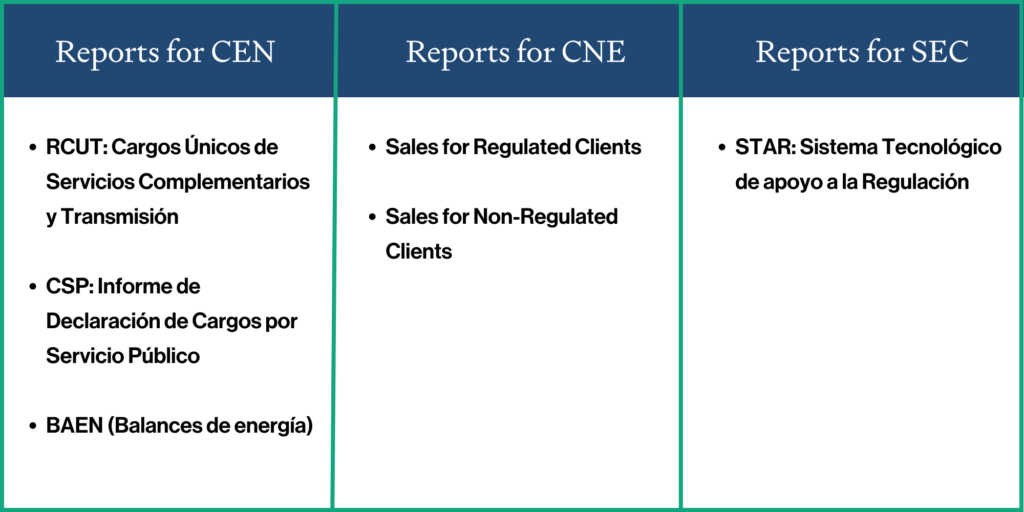Contributing to this blog post are Adriana Tamez, senior software consultant; Juan Torres, customer success manager; and Isabel Vega, associate software analyst.
Perhaps one of the most exciting things about the Chilean energy market is that generation, transmission, and distribution are all owned and operated by private companies, not the government, as is often found in other Latin and South American countries. Privatized in the 1980s, today, there are hundreds of active players in the market, some local, but many of which are multinational companies or their subsidiaries.
In this post, we’ll provide an overview of how PCI’s platform helped one company maximize its profits in the market by automating settlements, invoicing, and reporting. We’ll also give a brief overview of some of the things that make this market so unique.
Case study: Chilean electricity generator
Acciona, a large multinational generation company, was looking to streamline and centralize its settlements and invoicing processes. Their old system, which was spreadsheet-based, required three people to manually gather data from multiple platforms, check calculations, and generate multiple invoices for each customer every month. Because the work was so labor intensive, the entire process would take weeks.
Between the invoices the client generated and those they receive monthly for their transactions in the market, more than 1,000 invoices were being partially manually processed monthly.
Streamlining settlements and invoices
PCI’s platform is a great fit for this client because it allows them to manage supply and generation contracts, automate settlement calculations, trace and audit information at a granular level, and automatically integrate with electronic invoicing systems. Here’s how it works.
Contracts for our Chilean client’s 40-plus customers were entered into the system and supported individually. We customized the platform based on our client’s workflows to make ongoing contract management flexible and easy. For example, if the terms of a contract need to be updated, all the client has to do is change it in the PCI platform, and the system will automatically adjust the calculations associated with that contract.
In addition to managing customer contracts, the platform collects and stores all the data necessary for calculating settlements and generating invoices. With our Chilean client, the PCI system connects to the payment portal of Coordinador Electrico Nacional (CEN), the country’s independent grid coordinator. This process allows for a two-way transfer of the data needed for invoice processing. It’s important to note that the platform doesn’t just alert the client to invoices they need to generate but also tells them what invoices they should expect to receive.
In addition to CEN’s payment portal, the platform integrates with SAP, an electronic billing system, and a third-party provider that converts invoices into legal documents.
Automating the data-gathering process and having all the information needed to run settlement calculations and invoicing in a single platform has transformed how our client works. As a result, a single individual can complete the whole invoicing and settlement process in less than a week, minimizing costs to the company and maximizing its profits.
Streamlining compliance and reporting
Because the PCI solution offers a single source for all data related to settlements and invoicing, our customer can now quickly and easily generate the mandated compliance and regulatory reports.
Reports must be sent to both regulatory agencies overseeing Chile’s energy market: the National Energy Commission (Comisión Nacional de Energía or CNE) and the Superintendence of Electricity and Fuels (Superintendencia de Electricidad y Combustibles or SEC).
Reports must also be sent to the Coordinador Electrico Nacional (CEN), the organization that oversees the country’s electricity grid operation. Its role is comparable to that of an ISO in the U.S.
Required reports include:

Additionally, the platform allows our customers to create custom reports based on invoicing or metering data, income and expenditures, and more. These reports allow the leadership team to make data-informed decisions based on accurate information quickly.
Market overview
Chile has four balancing regions, though the two largest, the North Interconnected System and the Central Interconnected System, have been treated as a single market by CEN since 2017. At over 1,926 miles (3,100 km), spanning nearly the country’s entire length, these two systems account for almost 95% of Chile’s electricity demand.
Chile’s electric customers fall into two categories. Clientes libres, translated as unregulated customers, are end-consumers with more than 500 kW demand. Clientes libres can source power directly from generating companies thanks to open access to transmission and distribution facilities in the country.
Clientes regulados, or regulated customers, are end-consumers who demand 500 kW of power or less. Local distribution companies serve these clients, and, as the name implies, pricing for this market segment is regulated.
Most of the country’s electricity demand is served through long-term supply contracts, though there is an active spot market where excess energy is traded to make up for any shortfalls. Chile does not have a single price point for the entire market; instead, CEN manages more than 2,000 pricing nodes across the country’s balancing regions.
The future of the Chilean market is renewable
Nearly 40% of Chile’s electricity is renewable, taking advantage of the country’s natural features that make it ideal for wind, solar, and hydropower generation. The country is looking to boost that number to 70% by 2030.
But, as renewable generation has increased in Chile, some challenges around the wholesale electricity market have appeared. Many stakeholders are concerned that the current model puts energy projects at risk, primarily due to a lack of transmission planning and infrastructure. Additionally, entities with renewables-based generation say they are struggling to be profitable under the current pricing model.
Players in Chile’s renewable energy market have recently called for reforms to the internal processes used by the National Energy Commission (CNE) and the independent grid coordinator (CEN) to address these issues. However, there doesn’t seem to be a consensus among the stakeholders on how to solve these challenges best and market reform is not a top legislative priority. This evolving situation will need to be closely monitored.
A trusted partner in the Chilean energy market
Because of PCI’s knowledge of the Chilean market, PCI’s platform has allowed our client to thrive by streamlining operations and improving efficiencies around settlements, invoicing, and reporting.
Contact PCI Energy Solutions to learn more about how our customized software can support your energy operations in Chile.





